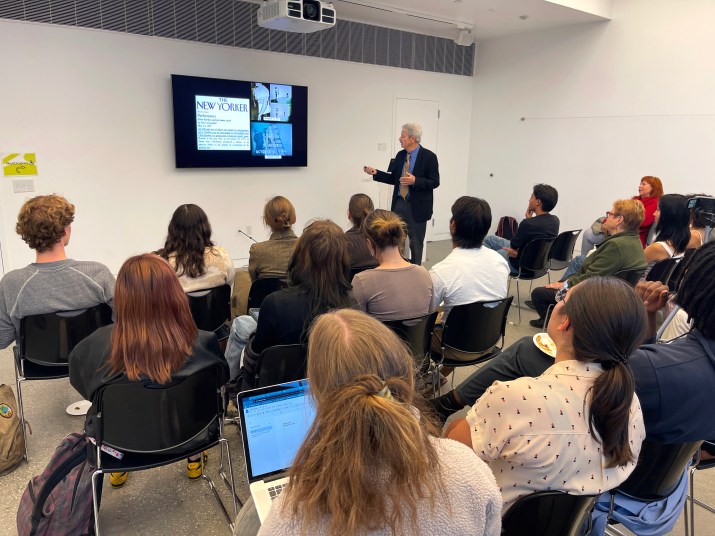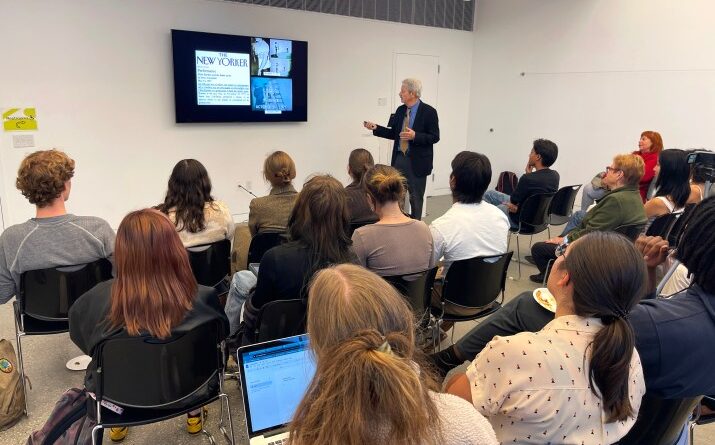The problem of the physics of art history: Charles Falco speaks at Benton – The Student Life

In this age where many people are afraid to make their own works of art, physicist Charles Falco reminds us that the intersection of technology and art is nothing new. In the afternoon of Nov. 14 At Pomona College’s Benton Museum of Art, Falco presented The Hockney-Falco thesisconsidered as “shak[en] foundations of art history.” According to the theory, Renaissance artists like Lorenzo Lotto and Hans Holbein didn’t just rely on raw talent – they used optics.
“Once you’ve seen the vision, you can’t see it,” Falco told the audience.
A master of the abstract, Falco’s legacy extends far beyond the Hockney-Falco thesis: His research has advanced our understanding of optics, visual perception and their intersection with historical art forms.
The story started with a chance meeting. As Pomona professor of physics and astronomy Dwight Whitaker says, it was Falco’s experience in motorcycle history that led him to take control. “Motorcycle Art” show at the Guggenheim in 1998, eventually connecting him with Hockney.
In 2000, Falco read a New Yorker article is a famous painter, who speculated that Renaissance painters would have used eye aids. Although many art historians rejected the idea, believing that the skill of these artists was due to knowledge alone, Falco saw an opportunity to seriously apply the question of art history.
What followed was a rare collaboration between an artist and a scientist that challenged centuries of conventional wisdom about art history.
“He wasn’t afraid to challenge some of David’s ideas and engage him as another scientist,” Whitaker said. “Through this open and honest discussion, they were able to fully develop their amazing idea.”
Together, Hockney and Falco discovered that artists were using sophisticated optical techniques almost 200 years earlier than previously thought possible.
“Let’s say optics is the only way to get the right view,” Falco said. “Optics is the only way to find false vision.”
This surprising statement undermines the depth of his research: Although skilled professionals could achieve perfect vision with one method, optical devices produced unique recommendations. When they used lenses or mirrors to project the images onto their canvases, the incongruous vanishing points were reduced by three degrees or the carpet sections were misaligned. These were not random errors, but rather symbolic “fingerprints” of optical devices, as distinct and recognizable as a signature hidden in the geometry of the images themselves.
Falco expressed this idea with “Man and Woman” by Lorenzo Lotto. First, he established an important point of reference: The woman’s shoulders were only 10 inches wide in the painting, while the average woman’s shoulders are 18 inches long.
“I know this because I have a wife and two daughters,” Falco laughed, drawing laughter from the audience.
“Let’s say that optics is the only way to get the right view. Optics is the only way to get false vision.”
Using this difference in scale, Falco calculated the optimal projection size for Lotto to use. When he visited St. Petersburg, Russia, took the picture at infrared and optical wavelengths. The analysis revealed something remarkable: The ornate carpet in the picture was traced in three separate areas, and the artist moved the lens to keep each area in focus. still working.
These discoveries suggested a deep connection between art and science in the Renaissance, challenging the common tendency to separate the two disciplines, Falco explained.
“It’s amazing that the tools that made the pictures possible themselves left subtle, measurable details of their use in the pictures themselves, which have enabled us to identify almost all of the properties of those tools. who used them,” said Whitaker.
Falco also demonstrated this in Holbein’s “The Ambassadors”. When the National Gallery in London restored the famous distorted skull at the bottom of the painting, they thought that Holbein used the anamorphic reproduction method – a method that distorts the image so that it can be viewed correctly from a certain angle. However, Falco’s analysis, based on high-resolution images from the restoration, suggested otherwise. The skull deformity was accompanied by signs of visual impairment. He even informed the Gallery that their assumption of restoration was wrong.
Falco vacillated between discussing optical physics and sharing anecdotes about art.
“As someone who likes physics and art, I liked to see how Dr. Falco used both to completely change the way we look at old pictures,” said Elsa Van Dyke PO ’28. “All the visions he came up with left me in awe.”
When asked how he balanced his work in physics with this artistic research, Falco smiled as he recounted the nights he spent reading art books and watching TV.
“This was a hobby,” Falco said. If I had done this earlier in my career, I probably would have gotten the job sooner!
Falco’s “hobbyism” has earned him accolades such as the Ziegfield Lecture Award from the National Art Education Association and the Dwight Nicholson Award from the American Physical Society.
Falco’s research does not diminish the achievements of Renaissance artists. Instead, it reveals them to be more complex than previously thought: They combined technical innovation with great intelligence.
As the afternoon sun beat down on the museum’s windows, Falco’s message was clear: The divide between art and science is deeper than we think. Sometimes, all it takes is a new way of seeing.
Related
